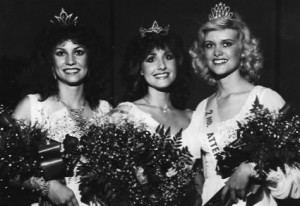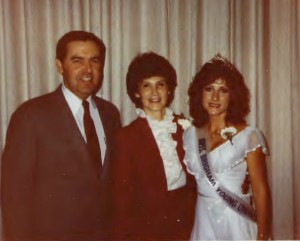Current BYU students aren’t used to having a university-sponsored pageant take place and perhaps don’t know it used to be a BYU reality. Former Miss BYU contestants and winners remember their experiences in the pageants as they celebrate Women’s History month.
Thirty female BYU students would compete for a chance at royalty each year in the Miss BYU homecoming pageant. Beginning in 1937, the pageant quickly paved a legacy of honor and poise as it became a school tradition.

While other universities currently sponsor pageants, the Miss BYU pageant ended in 1988. The decision to end the tradition was influenced by a statement made by President Spencer W. Kimball, as reported by the Deseret News.
“These queen contests — it seems every class, every group, every club, must have a queen,” President Kimball said. “The flattery resulting is frequently destructive to the queen. If I had 100 daughters, I would resist any one’s ever becoming a queen, the object of a beauty parade or contest.”
However, past contestants still like reminiscing about their experience of the historical, elegant tradition.
Teresa Chingas Harris said she was surprised when she was crowned queen in the 1982 pageant.
“It was the most shocking thing that ever happened to me. I still remember my dad holding that huge video camera on his shoulder, and he dropped it when they yelled out my name,” Harris said.
To be a contender in the pageant, contestants had to be single, have a high GPA, have completed at least 30 credit hours at BYU, fill out a pageant application, obey the Honor Code, wear a “street” length (below the knee) dress and wear an evening gown.
Miss BYU pageant contestants participated in most of the typical pageant components: they presented talents, answered on-stage questions and participated in the evening wear portion. Each contestant also interviewed with a panel of judges before the pageant.

Natalie Fullmer was crowned first attendant in the 1982 Miss BYU pageant. Fullmer was the BYU baton twirler for the marching band so she performed a baton twirling routine for her talent in the pageant.
“It was difficult to adapt my routine to the stage,” Fullmer said. “I was able to do it, but it was hard … but I did get a standing ovation at the end of that routine.”
Contestants walked out on stage in evening gown attire and answered an on-stage question in front of the audience.
Lynn Eyestone was crowned second attendant in the 1982 Miss BYU pageant.
“I remember tripping in the evening gown competition. That was exciting,” Eyestone said. “I did survive that. It just goes to show you that you can do dumb stuff and still live.”
Unlike most pageants, the Miss BYU pageant held no swimsuit competition.
“This pageant was different and I knew it,” Fullmer said. “It wasn’t part of the Miss America pageant system. It was its own thing.”
Some contestants were relieved BYU didn’t require a swimsuit portion. Harris said she doesn’t think she would have participated in the pageant if there were a swimsuit competition.

“To me, I just felt like that was irrelevant,” she said. “I think they handled the pageant very well because I like that they didn’t make it all about looks and body image.”
The pageant acted as a platform in finding a student to represent the university throughout the school year. Though the pageant was during Homecoming week, pageant duties for the queen lasted far past the homecoming parade and football game.
Pageant queens not only worked with students but with the administration as well, Harris said.

She worked with current LDS Apostle and former BYU president Jeffrey R. Holland. She said it was one highlight of her experience.
“That was one of the standouts of the year for me, getting to know him and his sweet wife,” Harris said. “I just love them. President Holland told me that I represent BYU and it was just such an honor to represent a place that I love.”
After the pageant and throughout the school year, Miss BYU spoke at schools, BYU events and LDS firesides.
Michelle Hyde, 1981’s Miss BYU, was very involved. “I was almost at every activity that they had, whether it was a Christmas dance or flag football event. They always invited me to come,” Hyde said.

After being crowned in the Miss BYU royalty, contestants could compete in other pageants such as Miss Provo, Miss Holiday Bowl and Miss Utah pageants. If contestants won the Miss Utah pageant, they could then compete in the Miss America pageant.
Eyestone competed in the 1983 Miss America Pageant. She said contestants put on their swimsuits right when they arrived in Atlantic City for Miss America to ensure the suits were modest. “Everyone wore a one-piece,” she said. “It was all about modesty. It just shows you how different society has changed.”
Despite the differences of pageants today, some current BYU students would like to see the tradition come back to campus.
BYU student Aly Peterson has participated in many pageants.
“I think it would be a lot of fun to bring it back,” Peterson said. “It would be a great way to gain more school spirit and have students be involved with everything going on at the university.”
Though there hasn’t been any talk about bringing the pageant back, participants say the respect for the pageant continues.
Harris said Miss BYU wasn’t a beauty pageant.
“It was about other things rather than just a beauty pageant,” she said. “It was an honor.”




